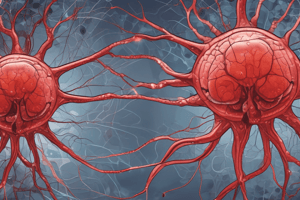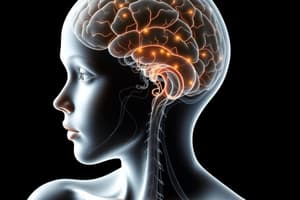Podcast
Questions and Answers
What is the initial, primary development of the CNS that occurs?
What is the initial, primary development of the CNS that occurs?
Consider the development of the CNS. What is the correct order of these stages?
Consider the development of the CNS. What is the correct order of these stages?
Which of the following is NOT a critical step in the development of neurons once they are formed?
Which of the following is NOT a critical step in the development of neurons once they are formed?
Gene and environmental influences are important to the development of the CNS, but what is especially emphasized in the case of “Genie”?
Gene and environmental influences are important to the development of the CNS, but what is especially emphasized in the case of “Genie”?
Signup and view all the answers
What does the example of “Genie” illustrate regarding the role of genes and the environment in the development of the CNS?
What does the example of “Genie” illustrate regarding the role of genes and the environment in the development of the CNS?
Signup and view all the answers
What are the two key factors that continuously interact throughout the development of the CNS?
What are the two key factors that continuously interact throughout the development of the CNS?
Signup and view all the answers
What is a key concept that challenges the traditional view of the brain as a stable organ after childhood?
What is a key concept that challenges the traditional view of the brain as a stable organ after childhood?
Signup and view all the answers
When the neural plate develops, where does the initial signal for the induction come from?
When the neural plate develops, where does the initial signal for the induction come from?
Signup and view all the answers
What is the primary purpose of gastrulation in embryonic development?
What is the primary purpose of gastrulation in embryonic development?
Signup and view all the answers
What technique is used in the study of zebrafish embryos, as mentioned in the provided references?
What technique is used in the study of zebrafish embryos, as mentioned in the provided references?
Signup and view all the answers
Which of the following is NOT a key factor contributing to the development of the central nervous system (CNS)?
Which of the following is NOT a key factor contributing to the development of the central nervous system (CNS)?
Signup and view all the answers
Which of the following is an example of a technique used to visualize neural structures, as mentioned in the references?
Which of the following is an example of a technique used to visualize neural structures, as mentioned in the references?
Signup and view all the answers
According to the provided references, what is a major challenge in understanding the development of the CNS?
According to the provided references, what is a major challenge in understanding the development of the CNS?
Signup and view all the answers
During neuronal development, which of the following is NOT a reason for neuronal death?
During neuronal development, which of the following is NOT a reason for neuronal death?
Signup and view all the answers
Which of the following is NOT a function of neurotrophins?
Which of the following is NOT a function of neurotrophins?
Signup and view all the answers
What is the main function of the process of neuronal cell death during development?
What is the main function of the process of neuronal cell death during development?
Signup and view all the answers
Which type of cell death is characterized as a 'clean' process?
Which type of cell death is characterized as a 'clean' process?
Signup and view all the answers
Why are developing neurons considered 'promiscuous' in terms of connections?
Why are developing neurons considered 'promiscuous' in terms of connections?
Signup and view all the answers
Which of the following is NOT a neurotrophin?
Which of the following is NOT a neurotrophin?
Signup and view all the answers
During neuronal development, what is the main outcome of competition for target-supplied neurotrophins?
During neuronal development, what is the main outcome of competition for target-supplied neurotrophins?
Signup and view all the answers
What is the significance of the fact that developing neurons make more focused synapses?
What is the significance of the fact that developing neurons make more focused synapses?
Signup and view all the answers
According to the Chemoaffinity Hypothesis, how do axons find their target?
According to the Chemoaffinity Hypothesis, how do axons find their target?
Signup and view all the answers
What type of evidence contradicts the Chemoaffinity Hypothesis?
What type of evidence contradicts the Chemoaffinity Hypothesis?
Signup and view all the answers
What is the role of fasciculation in axonal guidance?
What is the role of fasciculation in axonal guidance?
Signup and view all the answers
Which of these is NOT an example of evidence supporting the Topographic Gradient Hypothesis?
Which of these is NOT an example of evidence supporting the Topographic Gradient Hypothesis?
Signup and view all the answers
Which of these is NOT part of the revised Chemoaffinity Hypothesis?
Which of these is NOT part of the revised Chemoaffinity Hypothesis?
Signup and view all the answers
What type of cell is crucial for synapse formation?
What type of cell is crucial for synapse formation?
Signup and view all the answers
Which of the following is a key point in the Topographic Gradient Hypothesis?
Which of the following is a key point in the Topographic Gradient Hypothesis?
Signup and view all the answers
What is the significance of the fact that the frog optic tectum is homologous to the mammalian superior colliculus?
What is the significance of the fact that the frog optic tectum is homologous to the mammalian superior colliculus?
Signup and view all the answers
Which of these cell types is considered pluripotent?
Which of these cell types is considered pluripotent?
Signup and view all the answers
Which of the following is NOT a characteristic of totipotent stem cells?
Which of the following is NOT a characteristic of totipotent stem cells?
Signup and view all the answers
What type of stem cell is responsible for the development of neurons and glia of the peripheral nervous system (PNS)?
What type of stem cell is responsible for the development of neurons and glia of the peripheral nervous system (PNS)?
Signup and view all the answers
Which of the following cell types is NOT a derivative of the neural crest?
Which of the following cell types is NOT a derivative of the neural crest?
Signup and view all the answers
What is the significance of the mesoderm in the development of the neural plate?
What is the significance of the mesoderm in the development of the neural plate?
Signup and view all the answers
What is the main difference between totipotent and pluripotent stem cells?
What is the main difference between totipotent and pluripotent stem cells?
Signup and view all the answers
Which of the following is an example of a multipotent stem cell?
Which of the following is an example of a multipotent stem cell?
Signup and view all the answers
What is the significance of a chicken with teeth?
What is the significance of a chicken with teeth?
Signup and view all the answers
Which of the following is NOT a type of neural migration?
Which of the following is NOT a type of neural migration?
Signup and view all the answers
What is the primary function of cell adhesion molecules (CAMs) in neural development?
What is the primary function of cell adhesion molecules (CAMs) in neural development?
Signup and view all the answers
What is the defining characteristic of "smooth brain" or lissencephaly?
What is the defining characteristic of "smooth brain" or lissencephaly?
Signup and view all the answers
What is the primary role of the floor plate and roof plate in neural proliferation?
What is the primary role of the floor plate and roof plate in neural proliferation?
Signup and view all the answers
Which disorder is linked to a faulty cell adhesion molecule (CAM) protein?
Which disorder is linked to a faulty cell adhesion molecule (CAM) protein?
Signup and view all the answers
What is the main role of the growth cone in axonal growth?
What is the main role of the growth cone in axonal growth?
Signup and view all the answers
Which of the following statements accurately describes how the chemoaffinity hypothesis explains axonal growth?
Which of the following statements accurately describes how the chemoaffinity hypothesis explains axonal growth?
Signup and view all the answers
What is the correct order of events in neural development, from early to late?
What is the correct order of events in neural development, from early to late?
Signup and view all the answers
Flashcards
Prenatal Development
Prenatal Development
The stage of CNS development that occurs before birth.
Postnatal Development
Postnatal Development
CNS development that occurs after birth, through childhood to adulthood.
Brain Plasticity
Brain Plasticity
The ability of the brain to change throughout life.
Gametogenesis
Gametogenesis
Signup and view all the flashcards
Neural Plate Induction
Neural Plate Induction
Signup and view all the flashcards
Neural Tube
Neural Tube
Signup and view all the flashcards
Neurodevelopment Disorders
Neurodevelopment Disorders
Signup and view all the flashcards
Neuron Migration
Neuron Migration
Signup and view all the flashcards
Neural Crest
Neural Crest
Signup and view all the flashcards
Cellular Differentiation
Cellular Differentiation
Signup and view all the flashcards
Stem Cells
Stem Cells
Signup and view all the flashcards
Totipotent Stem Cells
Totipotent Stem Cells
Signup and view all the flashcards
Pluripotent Stem Cells
Pluripotent Stem Cells
Signup and view all the flashcards
Multipotent Stem Cells
Multipotent Stem Cells
Signup and view all the flashcards
Unipotent Stem Cells
Unipotent Stem Cells
Signup and view all the flashcards
Embryonic Stages
Embryonic Stages
Signup and view all the flashcards
Neural Proliferation
Neural Proliferation
Signup and view all the flashcards
Vesicles Formation
Vesicles Formation
Signup and view all the flashcards
Ventricular Zone Proliferation
Ventricular Zone Proliferation
Signup and view all the flashcards
Chemical Signals in Neural Development
Chemical Signals in Neural Development
Signup and view all the flashcards
Types of Neural Migration
Types of Neural Migration
Signup and view all the flashcards
Cell Adhesion Molecules (CAMs)
Cell Adhesion Molecules (CAMs)
Signup and view all the flashcards
Kallmann Syndrome
Kallmann Syndrome
Signup and view all the flashcards
Axon Growth Cone
Axon Growth Cone
Signup and view all the flashcards
Chemoaffinity Hypothesis
Chemoaffinity Hypothesis
Signup and view all the flashcards
Sperry’s Study
Sperry’s Study
Signup and view all the flashcards
Target Incorrect Innervation
Target Incorrect Innervation
Signup and view all the flashcards
Fasciculation
Fasciculation
Signup and view all the flashcards
Topographic Gradient Hypothesis
Topographic Gradient Hypothesis
Signup and view all the flashcards
Synaptogenesis
Synaptogenesis
Signup and view all the flashcards
Role of Astrocytes
Role of Astrocytes
Signup and view all the flashcards
Pioneer Growth Cones
Pioneer Growth Cones
Signup and view all the flashcards
In vivo studies
In vivo studies
Signup and view all the flashcards
Neuron death reasons
Neuron death reasons
Signup and view all the flashcards
Apoptosis
Apoptosis
Signup and view all the flashcards
Necrosis
Necrosis
Signup and view all the flashcards
Neurotrophins
Neurotrophins
Signup and view all the flashcards
Neuron connection surplus
Neuron connection surplus
Signup and view all the flashcards
Synaptic accuracy
Synaptic accuracy
Signup and view all the flashcards
Functions of neurotrophins
Functions of neurotrophins
Signup and view all the flashcards
Gastrulation
Gastrulation
Signup and view all the flashcards
Acetylated α-tubulin
Acetylated α-tubulin
Signup and view all the flashcards
Zebrafish Embryo
Zebrafish Embryo
Signup and view all the flashcards
Light-sheet Fluorescence Microscopy
Light-sheet Fluorescence Microscopy
Signup and view all the flashcards
Immunostaining
Immunostaining
Signup and view all the flashcards



